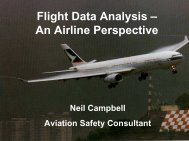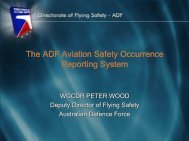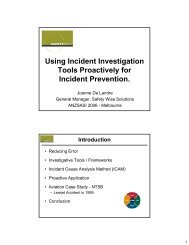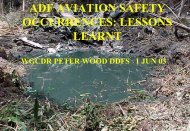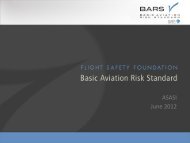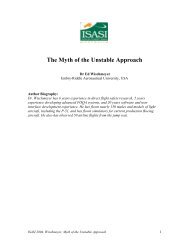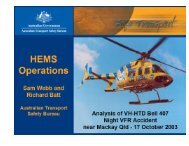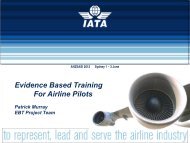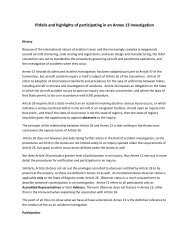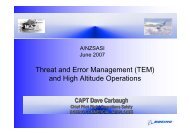Very little has been written about <strong>communication</strong> issues <strong>in</strong> <strong>aviation</strong> ma<strong>in</strong>tenance <strong>and</strong><strong>in</strong>spection. The FAA did sponsor a two day meet<strong>in</strong>g <strong>in</strong> December 1989 which focusedon <strong>in</strong>formation exchange <strong>and</strong> <strong>communication</strong> <strong>in</strong> the ma<strong>in</strong>tenance area (Parker &Shepherd, 1990). Latorella <strong>and</strong> Prabhu (2000) note that <strong>communication</strong> is a contribut<strong>in</strong>gfactor to error <strong>in</strong> <strong>aviation</strong> ma<strong>in</strong>tenance. Some research regard<strong>in</strong>g <strong>communication</strong> <strong>in</strong> thema<strong>in</strong>tenance arena would be worthwhile, especially <strong>in</strong>to the effectiveness of writtendocuments which Piotrowski (1990) amd Majoros (1990) ma<strong>in</strong>ta<strong>in</strong> is an important part ofma<strong>in</strong>tenance <strong>communication</strong>. Aviation ma<strong>in</strong>tenance is an area where jargon <strong>and</strong>acronyms abound (Taylor, 1990). It would be important to <strong>in</strong>vestigate how the usejargon <strong>and</strong> acronyms impacts <strong>aviation</strong> <strong>safety</strong> with<strong>in</strong> ma<strong>in</strong>tenance itself <strong>and</strong> from a widerperspective.These suggestions are but a few that might be important to <strong>in</strong>vestigate regard<strong>in</strong>g theeffects of <strong>communication</strong> <strong>in</strong> <strong>aviation</strong> <strong>safety</strong>. Given the critical nature of <strong>communication</strong>many other research areas with<strong>in</strong> the cockpit, the cab<strong>in</strong>, <strong>and</strong> <strong>in</strong>teractions between airl<strong>in</strong>ecrew <strong>and</strong> other parts of the <strong>aviation</strong> system are ripe for research study.THE NEED FOR COMMUNICATION TRAININGThere have been numerous calls for <strong>communication</strong> tra<strong>in</strong><strong>in</strong>g, both as an <strong>in</strong>dependenteffort <strong>and</strong> as part of Crew Resource Management (CRM) for flight crews <strong>and</strong> for flightattendants (Baker & Frost; 1994; Butler, 1993; Chidester & Vaughn, 1994; Chute &Wiener, 1996; Edwards, 1992; Federal Aviation Adm<strong>in</strong>istration, 1988, 2004; Grommes<strong>and</strong> Dietrich, 2002; Helmreich, 2000; Sexton & Helmreich, 2000; Young, 1994).Perhaps, more important have been the calls for jo<strong>in</strong>t pilot-flight attendant tra<strong>in</strong><strong>in</strong>g(Baker & Frost, 1994; Butler, 1993; Chidester & Vaughn, 1994; Chute & Wiener, 1995,1996; ETSC, 1996; Federal Aviation Adm<strong>in</strong>istration, 2004; Helmreich, Wiener, & Kanki,1993; Kayten, 1993; Murphy, 2001; Moshansky, 1994, NTSB, 2000). “We must teachcrews that <strong>communication</strong> <strong>and</strong> cooperation are <strong>safety</strong> issues” (Chute, Wiener, Dunbar, &Hoang, 1996, p. 17).Flight <strong>and</strong> cab<strong>in</strong> crew, while a critical part of the <strong>aviation</strong> environment, should not be theonly focus of <strong>communication</strong> tra<strong>in</strong><strong>in</strong>g as part of an <strong>aviation</strong> <strong>safety</strong> tra<strong>in</strong><strong>in</strong>g program.Flight Safety Foundation (2000) notes that tra<strong>in</strong><strong>in</strong>g programs should <strong>in</strong>clude specialemphasis on pilot controller <strong>communication</strong>. Thomas (2005b) <strong>and</strong> Thomas <strong>and</strong> Petrilli(2004) argue for <strong>communication</strong> tra<strong>in</strong><strong>in</strong>g as part of error management. Latorella <strong>and</strong>Prabhu (2000) <strong>and</strong> Petrowski (1990) note that the importance of <strong>communication</strong> <strong>in</strong><strong>aviation</strong> ma<strong>in</strong>tenance tra<strong>in</strong><strong>in</strong>g. Baron (2002) emphasizes the importance of provid<strong>in</strong>gtra<strong>in</strong><strong>in</strong>g about runway <strong>in</strong>cursions for pilots, controllers, <strong>and</strong> ground vehicle operators.Etem & Patten (1998) suggest the need for <strong>communication</strong> tra<strong>in</strong><strong>in</strong>g <strong>in</strong> flight <strong>in</strong>struction.However, such calls for tra<strong>in</strong><strong>in</strong>g generally do not often <strong>in</strong>clude or <strong>in</strong>dicate which<strong>communication</strong> topics are needed, especially when it comes to <strong>in</strong>terpersonal<strong>communication</strong> tra<strong>in</strong><strong>in</strong>g; nor are the specific subtopics needed to help <strong>in</strong>crease<strong>communication</strong> effectiveness generally explicated. The Federal Aviation Adm<strong>in</strong>istration22
(2004) offers some general <strong>communication</strong> topics, which this paper will exp<strong>and</strong> uponwith regard to <strong>communication</strong> tra<strong>in</strong><strong>in</strong>g, <strong>in</strong>clud<strong>in</strong>g <strong>in</strong>terpersonal <strong>communication</strong>, listen<strong>in</strong>gskills, decision-mak<strong>in</strong>g skills, <strong>and</strong> conflict management, though they did <strong>in</strong>dicate, asnoted above that cockpit-cab<strong>in</strong> crew <strong>communication</strong> coord<strong>in</strong>ation cont<strong>in</strong>ues to challengethe <strong>aviation</strong> system (Federal Aviation Adm<strong>in</strong>istration, 2004). The Federal AviationAdm<strong>in</strong>istration (2004) also offers some specific areas where jo<strong>in</strong>t cab<strong>in</strong>-cockpit<strong>communication</strong> tra<strong>in</strong><strong>in</strong>g can focus, <strong>in</strong>clud<strong>in</strong>g pre-flight brief<strong>in</strong>gs, post <strong>in</strong>cident <strong>and</strong>accident procedures, sterile cockpit procedures, notifications <strong>and</strong> pre-flight, pre-l<strong>and</strong><strong>in</strong>g,<strong>and</strong> turbulence passenger-h<strong>and</strong>l<strong>in</strong>g issues.In addition, the Federal Aviation Adm<strong>in</strong>istration (2004) notes that the “importance ofclear <strong>and</strong> unambiguous <strong>communication</strong> must be stressed <strong>in</strong> all tra<strong>in</strong><strong>in</strong>g activities<strong>in</strong>volv<strong>in</strong>g pilots, flight attendants, <strong>and</strong> aircraft dispatchers” (p. 10). As noted previously<strong>communication</strong> is a two-way transaction, not a one-way transfer. Thus the concepts ofperception <strong>and</strong> mean<strong>in</strong>g are important to <strong>in</strong>clude <strong>in</strong> any <strong>communication</strong> tra<strong>in</strong><strong>in</strong>g. Wecommunicate about the world <strong>in</strong> the way we perceive it, therefore, everyone <strong>in</strong> the<strong>aviation</strong> <strong>safety</strong> system needs to underst<strong>and</strong> how perception operates <strong>and</strong> how peoplediffer, sometimes radically, <strong>in</strong> the ways they perceive a situation.Layered upon differ<strong>in</strong>g perceptions is the concept that when we communicate about theworld, we do so <strong>in</strong> symbolically, so that we give mean<strong>in</strong>g to our perceptions. As we haveseen, people will <strong>in</strong>terpret messages <strong>in</strong> such a way that makes sense to them <strong>and</strong> makessense of the world around them. George (1993) <strong>and</strong> Matchette (1995) provide severalsuggestions, some <strong>in</strong>clud<strong>in</strong>g the use or misuse of jargon, for improv<strong>in</strong>g <strong>communication</strong>between pilots <strong>and</strong> controllers that can be <strong>in</strong>corporated <strong>in</strong>to any <strong>communication</strong> tra<strong>in</strong><strong>in</strong>gfor <strong>aviation</strong> <strong>safety</strong>. Thus, the areas of perception, language (<strong>in</strong>clud<strong>in</strong>g mean<strong>in</strong>g <strong>and</strong>jargon) need to be part of any <strong>communication</strong> tra<strong>in</strong><strong>in</strong>g for <strong>aviation</strong> <strong>safety</strong>. As we<strong>in</strong>dicated earlier, feedback <strong>and</strong> ask<strong>in</strong>g questions are critical to greater success <strong>and</strong>effectiveness <strong>in</strong> our <strong>communication</strong> <strong>in</strong>teractions. Majoros (1990) re<strong>in</strong>forces the need forfeedback as one method to improve <strong>communication</strong> effectiveness.In addition to the exploration of the effects of mean<strong>in</strong>g <strong>and</strong> jargon on <strong>communication</strong>,two other related concepts need to be <strong>in</strong>cluded: message distortion <strong>and</strong> <strong>in</strong>formationoverload—<strong>and</strong> how to m<strong>in</strong>imize them. As much as we underst<strong>and</strong> <strong>and</strong> desire to haveclear <strong>and</strong> unambiguous <strong>communication</strong>, especially regard<strong>in</strong>g <strong>aviation</strong> <strong>safety</strong> issues, giventhe nature of language <strong>and</strong> human <strong>in</strong>teraction, we can only hope to m<strong>in</strong>imize messagedistortion <strong>and</strong> <strong>in</strong>formation overload. Underst<strong>and</strong><strong>in</strong>g these important <strong>communication</strong>barriers <strong>and</strong> how to deal with them effectively are needed <strong>in</strong> cab<strong>in</strong> <strong>safety</strong> tra<strong>in</strong><strong>in</strong>g. As faras <strong>in</strong>terpersonal <strong>communication</strong> tra<strong>in</strong><strong>in</strong>g is concerned, more <strong>in</strong> depth treatment of suchareas as establish<strong>in</strong>g a positive, supportive <strong>communication</strong> climate, underst<strong>and</strong><strong>in</strong>g howtrust <strong>and</strong> credibility are achieved, conflict management skills, <strong>and</strong> active listen<strong>in</strong>g isrequired.The process of conflict, underly<strong>in</strong>g reasons for conflict, <strong>and</strong> effective <strong>communication</strong>behaviors dur<strong>in</strong>g conflict are also crucial topics <strong>in</strong> this area of <strong>aviation</strong> <strong>safety</strong> tra<strong>in</strong><strong>in</strong>g.For example cab<strong>in</strong> crew assertiveness—with respect to evacuations, poor passenger23



